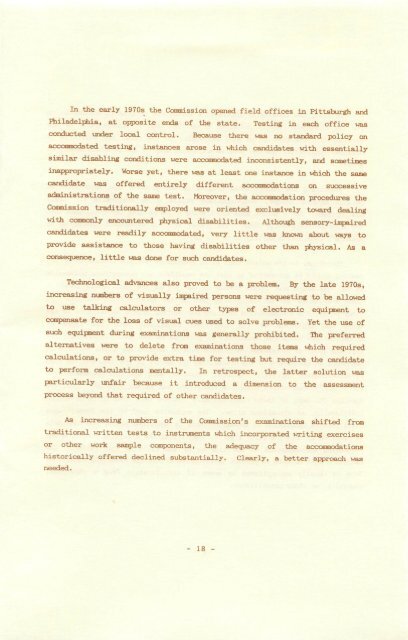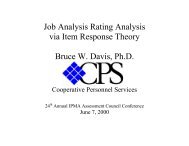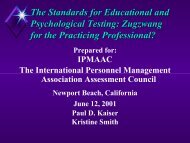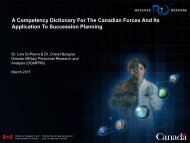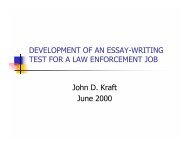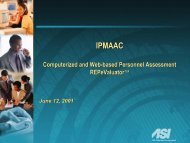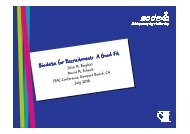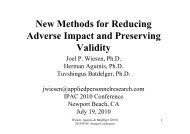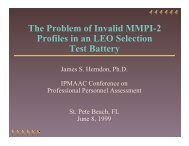Employment Testing of Persons with Diasabling Conditions - IPAC
Employment Testing of Persons with Diasabling Conditions - IPAC
Employment Testing of Persons with Diasabling Conditions - IPAC
Create successful ePaper yourself
Turn your PDF publications into a flip-book with our unique Google optimized e-Paper software.
In the early 1970s the Commission opened field <strong>of</strong>ficea in Pittsburgh and<br />
Philadelphia, at opposite endB <strong>of</strong> the state. <strong>Testing</strong> in each <strong>of</strong>fice was<br />
conducted under local control. Because there was no standard policy on<br />
accommodated testing, instances arose in which candidates <strong>with</strong> essentiallysimilar<br />
disabling conditions were aceamnodated inconsistently, and sometimes<br />
inappropriately. Worse yet, there was at least one instance in which the same<br />
candidate was <strong>of</strong>fered entirely different accommodations on successive<br />
administrations <strong>of</strong> the same test. Moreover, the accommodation procedures the<br />
Commission traditionally employed were oriented exclusively toward dealing<br />
<strong>with</strong> commonly encountered physical disabilities. Although sensory-impaired<br />
candidates were readily acconmodated, very little was known about ways to<br />
provide assistance to those having disabilities other than physical. As a<br />
consequence, little was done for such candidates.<br />
Technological advances also proved to be a problem. By the late 1970s,<br />
increasing numbers <strong>of</strong> visually impaired persons were requesting to be allowed<br />
to use talking calculators or other types <strong>of</strong> electronic equipment to<br />
compensate for the loss <strong>of</strong> visual cues used to solve problems. Yet the use <strong>of</strong><br />
such equipment during examinations was generally prohibited. The preferred<br />
alternatives were to delete from examinations those items which required<br />
calculations, or to provide extra tijne for testing but require the candidate<br />
to perform calculations mentally. In retrospect, the latter solution was<br />
particularly unfair because it introduced a dimension to the assessment<br />
process beyond that required <strong>of</strong> other candidates.<br />
As increasing numbers <strong>of</strong> the Commission's examinations shifted from<br />
traditional written tests to instruments which incorporated writing exercises<br />
or other work sample components, the adequacy <strong>of</strong> the accommodations<br />
historically <strong>of</strong>fered declined substantially. Clearly, a better approach was<br />
needed.<br />
- 18 -


